Mānuka oil is an essential oil derived from Leptospermum scoparium, a plant that has been used by the indigenous populations of New Zealand and Australia for centuries. Both the extracted oil and its individual components have been associated with various medicinal properties. This entry aimed to collate available evidence on the antimicrobial, anti-parasitic and anti-inflammatory activities of mānuka oil and its components. Given the rise in resistance to conventional antibiotics, natural products have been targeted for the development of antimicrobials with novel mechanism of action. The present entry found extensive in vitro data supporting the antimicrobial effects of mānuka oil warrants further clinical studies to establish its therapeutic potential. Clinical evidence on its efficacy, safety and dosing guidelines are necessary for its implementation for medical purposes. Further work on regulation, standardization and characterization of the medicinal properties of mānuka oil is required for establishing consistent efficacy of the product.
- mānuka oil
- Leptospermum scoparium
- antimicrobial
- antibacterial
- antiparasitic
- medicinal
- therapeutic properties
1. Introduction
Mānuka (Leptospermum scoparium), also known as kahikatoa, red mānuka and tea tree, belongs to the Myrtaceae plant family and is found throughout New Zealand and Australia [1]. Commonly grouped under ‘tea trees,’ which also includes Camellia sinensis, Kunzea ericoides, Leptospermum petersonii and Melaleuca alternifolia, these species have been used by the Māori, the Aboriginals and early European settlers as topical preparations for wounds, cuts, sores and skin diseases and as inhalations for colds and fevers. Interest in the medicinal properties of mānuka, particularly mānuka honey, has grown over the last 30 years. There is also a growing interest in the volatile oil due to its potential application as a medicinal agent or cosmetic ingredient [2][3]. Currently, there has not been a critical review on the efficacy and potential applications of mānuka oil while there have been extensive reviews on Mānuka honey and its medical applications.
2. Chemical Composition and Medicinal Properties
2.1. Chemical Composition
Mānuka oil (CAS 219828- 87-2) is a volatile essential oil derived from the foliage, bark and seeds of Leptospermum scoparium plants of the Myrtaceae family of trees and shrubs [4]. A clear liquid with an aromatic odor is produced by a steam distillation process from plants harvested mostly in the autumn, summer and spring, with a yield ranging from 0.2–1%, depending on seasonal and geographical factors [5][6] (also commercial data held by Phytomed Medicinal Herbs Ltd., Auckland, New Zealand). The oil is generally distilled using leaves and young stems, although oil has also been produced from the seeds [5][7]. The use of biowaste fertilizer has recently been reported to enhance oil production and content [8].
A large number of studies have examined the constituents of mānuka oil, which vary depending on the source of the oil [7][9][10] as well as the plant chemotype and season of collection [11]. Overall, 100 components were identified from 16 commercial samples of mānuka oil, of which 51 components made up 95% of the content [7]. The major components of commercially available mānuka oils are reported to be leptospermone (0.8–19.4%), calamenene (2.5–18.5%), δ-cadinene (0.9–6.9%), cadina-1,4-diene (0.1–5.9%), flavesone (0.7–5.8%), cadina-3,5-diene (3.0–10.0%), α-copaene (4.3–6.5%) and α-selinene (1.3–5.0%) (Table 1) [7][9][11][12][13][14]. Chemotypes found in the East Coast of the North Island of New Zealand tend to contain higher levels of β-triketones than oil sourced from other regions [11]. The compartmentalization of β-triketones and grandiflorone within oil glands inside mānuka leaves may defend the plants against mānuka’s herbicidal activity [15]. There are also some types of L. scoparium that are high in α-pinene (21.5%) [11], though the majority of plants possess lower levels of this monoterpene (0.6–11%) [7][9][10][11].
Table 1. Chemical composition of Mānuka oil and known properties of each component.
| Component | Percentage in Commercial Compositions | IUPAC Name | Known Properties | Ref. |
|---|---|---|---|---|
| α-pinene | Up to 21.5% |  |
Reported to have antibiotic resistance modulation, anticoagulant, antitumor, antimicrobial, antimalarial, antioxidant, anti-inflammatory, anti-Leishmania, and analgesic effects in association with other essential oils. | [16][17] |
| Leptospermone | 0.8–19.4% | 6-isovaleryl-2,2,4,4-tetramethyl-1,3,5-cyclohexanetrione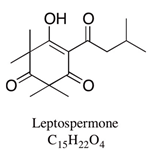 |
Herbicidal; antibacterial: treatment with 5–20 mg/disc of concentrate was effective against foodborne bacteria: Listeria monocytogenes, Staphylococcus aureus and Staphylococcus intermedius and three Gram-negative bacteria: Salmonella typhimurium, Shigella flexneri and Shigella sonnei | [18][19][20] |
| Calamenene | 2.5–18.5% | 1,6-Dimethyl-4-isopropyltetralin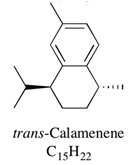 |
Major constituent of mānuka oil; contributes to insecticidal, antiseptic, bactericidal, analgesic and anti-inflammatory properties. Antibacterial effect against S. aureus and MRSA was shown. |
[12][21] |
| δ-cadinene | 0.9–6.9% | 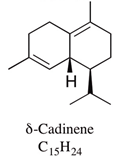 |
Pesticidal effects against mosquito have been shown for constituents isolated from Kadsura heteroclita leaf oil. | [22] |
| Cadina-1,4-diene | 0.1–5.9% | 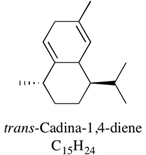 |
Not reported | |
| Cadina-3,5-diene | 3.0–10.0% | 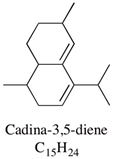 |
Not reported | |
| Flavesone | 0.7–5.8% | 2,2,4,4-Tetramethyl-6-(3-methylbutanoyl)cyclohexane-1,3,5-trione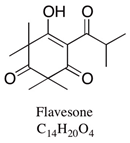 |
Antiviral properties. | [23] |
| α-copaene | 4.3–6.5% | (1R,2S,6S,7S,8S)-8-isopropyl-1,3-dimethyltricyclo[4.4.0.02,7]dec-3-ene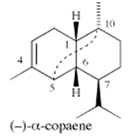 C15H24 |
Enhances mating in male Mediterranean fruit flies; Lures for trapping Redbay ambrosia beetle (Xyleborus glabratus). | [24][25] |
| α-selinene | 1.3–5.0% | 7-Epi-alpha-Selinene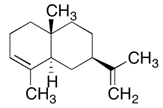 α-selinene C15H24 |
Insecticidal: retarding the growth of mosquito larvae. | [21] |
| α-terpineol | 1–2% | 2-(4-methylcyclohex-3-en-1-yl)propan-2-ol C10H18O |
Antifungal effects; preservative for the postharvest storage of grapes and other fruits; has been shown to suppress the production of inflammatory mediators when sourced from Tea tree oil. | [26][27] |
| terpinene-4-ol | 0.8–1.4% | 4-methyl-1-propan-2-ylcyclohex-3-en-1-ol C10H18O |
Spasmolytic activity; anti-inflammatory properties have been characterized in constituent isolated from Melaleuca alternifolia. | [28] |
* IUPAC names were obtained from https://pubchem.ncbi.nlm.nih.gov/compound/; Chemical structures were obtained from https://pubchem.ncbi.nlm.nih.gov/.
Variation of the components in mānuka oil was found both between and within natural populations of L. scoparium [7][11][16]. Higher levels of triketones (known to have strong antibacterial properties) were predominant in samples from the East Cape population. Higher levels of the monoterpenes, α- and β-pinene, were present in the Northland populations [16]. Samples from L. scoparium grown in Australia had higher monoterpene levels and almost no triketones compared to those from New Zealand [16]. Mānuka oil from New Zealand was shown to have low concentrations of monoterpenes in comparison to kanuka oil (75% α-pinene) and negligible amounts of terpinen-4-ol and 1,8-cineole predominant in Australian tea tree oil [7]. In general, mānuka oils from different geographic locations around New Zealand can be simplified into 3 basic chemo-type groups based on the ratio of the monoterpenes:sesquiterpenes:ß-triketones [29]. These include triketone-rich in the East Cape (marketed as Manex™), monoterpene-, linalool- and eudesmol-rch in Nelson (Kaiteriteri™) and monoterpene- and pinene rich in Canterbury [5][9][16][30]. A varied chemotype in mānuka grown in South Africa in comparison to New Zealand-grown was shown by van Vurren [31]. The age of the plant also plays a role in the nature of the essential oil, with higher sesquiterpene content in young plants and a mixed amount of monoterpenes and sesquiterpenes in mature ones [9].
The lack of consistency in constituents is a common problem with natural extracts and a source of inconsistency in medicinal properties [32]. Though mānuka oil is listed under the New Zealand Inventory of chemicals (CAS 219828- 87-2), ECHA (CAS 223749-44-8) and EINECS (425-630-7), further research into regulation, standardization and characterization of the medicinal properties from varying origins is required.
2.2. Medicinal Properties
Mānuka grows abundantly throughout New Zealand and has been a part of traditional Maori medicine for a variety of applications. The bark of the tree has been used for the treatment of skin diseases, as a sedative and as a mouthwash. The leaves are boiled in water for treating colds or crushed and applied to ease itching and scabs, while the leaves have been used as tea, as a febrifuge and for pain relief. The seeds were used for treating dysentery and diarrhea [33][34]. Contemporary data, prominently from in vitro studies, clearly demonstrates a broad spectrum of antibacterial, antifungal, anti-parasitic/insecticidal, anti-inflammatory, antiviral and spasmolytic activity.
2.3 Antibacterial Activity
The antibacterial activity of mānuka oil is the most characterized, being effective against both Gram-positive and Gram-negative bacteria. These effects are variable depending on the type and source of the oil.
2.4 Antifungal Activity
Varying rate of inhibition against a wide range of fungi were shown using fumigant and microdilution methods depending on the source of Manuka oil. Inhibitory effects were shown against phytopathogenic fungi, Aspergillus niger, A. ochraceous, F. culmorum, Malassezia furfur, Trichosporon mucoides, Candida albicans and C. tropicalis.
2.5 Antiparasitic/Insecticidal Activity
Several studies demonstrated antiparasitic activity of mānuka oil against parasites with significant impact on plants, humans and animals including poultry red mites (Dermanyssus gallinae), scabies (Sarcoptes scabei), house dust mites (Dermatophagoides farina and D. pteronyssinus), stored product mites (Tyrophagus putrescentiae) and mosquitos (Aedes aegypti). Mānuka oil has also been used as a lure to attract Xyleborus glabratus (Redbay ambrosia beetle), an exotic wood-borer that transmits the fungal agent (Raffaelea lauricola) responsible for laurel wilt, which has had a severe impact on forest ecosystems in South-East United States.
2.6 Anti-Inflammatory Effects
Experiments to assess the anti-inflammatory potential of mānuka oil found that THP-1 cells stimulated with lipopolysaccharide (LPS) and co-treated with 0.1–10% mānuka oil had significantly reduced release of TNF-α but there was no significant effect on the release of IL-4.
2.7 Photo-Protective Effects
Solar ultraviolet (UV) radiation is the primary environmental factor causing skin damage and consequently premature aging. Kwon et al. (2013) evaluated mānuka oil (from Coast Biologicals Ltd., Auckland, New Zealand) for its effects against photoaging in UV-B-irradiated hairless mice. After 8 weeks of exposure to UVB radiation, mice that were treated topically with 10% mānuka oil experienced a reduction in typical UVB-related skin changes, such as skin thickening, appearance of wrinkles and loss of skin collagen.
2.8 Antiviral Activity
Pre-treatment with a β-triketone-rich mānuka oil has been reported to exhibit inhibitory effects on HSV-1 and HSV-2.
3. Safety and Tolerance
Mānuka oil, like other essential oils, has been classified as safe and tolerable for human use (CAS (US and EU) 223749-44-8; CTFA monograph ID 10572 and EINECS 425-630-7). However, the lack of clinical trials means there is limited data to inform dosing practices and toxicology profiles. No signs of toxicity were observed on treatment with 10% active aqueous or oily phase of the cosmetic formulation for Campo Mānuka Oil Extract in fibroblast cells. In vitro organogenesis assay (Living Dermal Matrix (LDM)), a toxicity assay that closely mimics the effect of a substance on human skin, consists of skin cells in a 3D-construct made of collagen. The LDM test proved Campo Mānuka oil to be non-irritant with 99.4% cell viability after treatment with an undiluted sample in comparison to 100% propylene glycol (73%; a non-irritant) and 100% morpholine (6%; a moderate irritant).
4. Future Directions
Mānuka oil has been extensively used in traditional medicinal preparations and its individual fractions, particularly β-triketone constituents, exhibit many bioactive properties. Yet its application in clinical medicine remains under explored. The emergence of new strains of pathogens, including bacteria, viruses, parasites and fungi, coupled with the continued rise in antibiotic resistance, warrants further study of the potential antimicrobial activity of essential oils as therapeutic agents for their control and eradication. In contrast to tea tree oil, there is limited evidence on the efficacy and safety of mānuka oil in terms of geographic origin, parts of the plant used, dilutions and variation among formulations. The elucidated mechanisms of action exerted by topical application of mānuka oil are general to those of essential oils. Further reproducible studies looking into the mechanistic and lethal action of mānuka oil as well as its fractions are required to accurately compare efficacy between formulations and sources of the oil. Future studies on the synergistic efficacy of mānuka oil with synthetic drugs or other essential oils could improve its efficacy against pathogen, for instance Gram negative bacteria. In vivo studies on the medicinal properties of mānuka oil could inform therapeutic and interventional clinical trials. Additionally, there is a clear need for standardization of manuka oil (e.g., the International Organization for Standardization [ISO] and Association Française de Normalization [AFNOR] for quality specification of key bioactive terpene components) to meet the growing needs of therapeutic grade product.
5. Conclusion
With emerging resistance to drug-based antimicrobial and anti-parasitic treatments, as well as a growing interest in alternative therapies, the extensive in vitro data supporting the medicinal properties of mānuka oil warrant further clinical studies to characterize its true therapeutic benefits. Commercialization and therapeutic application of mānuka oil requires extensive regulation and standardization of the oil and clinical evidence for its medicinal properties. The review highlights an underutilized essential oil with potential medical applications similar to tea tree oil and mānuka honey. Further characterization of antimicrobial activity of manuka oil will clearly improve its potential to become a clinically useful product. The current in vitro data suggest that manuka oil products may have efficacy in the treatment of many cutaneous skin infections. These data also provide a sound basis from which to proceed to in vivo and clinical work—which is critical in translating early laboratory findings into clinically useful outcomes.
Since the mechanism of action has implications for the selectivity and safety of antimicrobial agents, this issue is becoming increasingly important. Despite growing interest in the oil for therapeutic purposes, the current data remains limited, highlighting the need for further research to understand how manuka oil works. There is enormous potential to expand the manuka oil industry if claims about its medicinal properties are to be verified. Scientific validation regarding the antimicrobial activity of manuka oil may assist in accessing of international markets and the registration of the oil with national regulatory bodies.
This entry is adapted from the peer-reviewed paper 10.3390/ph13110343
References
- Wilson, P.G.; O’Brien, M.M.; Gadek, P.A.; Quinn, C.J.; Quinn, P.A.G.J. Myrtaceae revisited: A reassessment of infrafamilial groups. Am. J. Bot. 2001, 88, 2013–2025.
- Maddocks-Jennings, W.; Wilkinson, J.M.; Cavanagh, H.; Shillington, D. Evaluating the effects of the essential oils Leptospermum scoparium (manuka) and Kunzea ericoides (kanuka) on radiotherapy induced mucositis: A randomized, placebo controlled feasibility study. Eur. J. Oncol. Nurs. 2009, 13, 87–93.
- Carson, C.F.; Riley, T.V. Safety, efficacy and provenance of tea tree (Melaleuca alternifolia) oil. Contact Dermat. 2001, 45, 65–67.
- Avonto, C.; Chittiboyina, A.G.; Wang, M.; Vasquez, Y.; Rua, D.; A Khan, I. In Chemico Evaluation of Tea Tree Essential Oils as Skin Sensitizers: Impact of the Chemical Composition on Aging and Generation of Reactive Species. Chem. Res. Toxicol. 2016, 29, 1108–1117.
- Broadsheet, C.F.R. Essential Oil Production from Manuka & Kanuka. Available online: https://tararuacropping.files.wordpress.com/2016/08/essential-oil-manuka-may-2014_kanuka.pdf (accessed on 20 June 2020).
- Melora. Cosmetic Product Safety Report: MELORA™ Mānuka Oil; Melora: Dublin, Ireland, 2017.
- Christoph, F.; Kubeczka, K.-H.; Stahl-Biskup, E. The Composition of Commercial Manuka Oils from New Zealand. J. Essent. Oil Res. 1999, 11, 705–710.
- Seyedalikhani, S.; Esperschuetz, J.; Dickinson, N.; Hofmann, R.; Breitmeyer, J.; Horswell, J.; Robinson, B. Biowastes to augment the essential oil production of Leptospermum scoparium and Kunzea robusta in low-fertility soil. Plant Physiol. Biochem. 2019, 137, 213–221.
- Porter, N.G.; Smale, P.E.; Nelson, M.A.; Hay, A.J.; Van Klink, J.W.; Dean, C.M. Variability in essential oil chemistry and plant morphology within aLeptospermum scopariumpopulation. N. Z. J. Bot. 1998, 36, 125–133.
- Porter, N.G.; Wilkins, A.L. Chemical, physical and antimicrobial properties of essential oils of Leptospermum scoparium and Kunzea ericoides. Phytochemistry 1999, 50, 407–415.
- Douglas, M.H.; Van Klink, J.W.; Smallfield, B.M.; Perry, N.B.; Anderson, R.E.; Johnstone, P.; Weavers, R.T. Essential oils from New Zealand manuka: Triketone and other chemotypes of Leptospermum scoparium. Phytochemistry 2004, 65, 1255–1264.
- Christoph, F.; Kaulfers, P.M.; Stahl-Biskup, E. In vitro evaluation of the antibacterial activity of β-triketones admixed to Melaleuca oils. Planta Med. 2001, 67, 768–771.
- Christoph, F.; Stahl-Biskup, E.; Kaulfers, P.M. Death Kinetics of Staphylococcus aureus Exposed to Commercial Tea Tree Oils s.l. J. Essent. Oil Res. 2001, 13, 98–102.
- Fang, F.; Candy, K.; Melloul, E.; Bernigaud, C.; Chai, L.; Darmon, C.; Durand, R.; Botterel, F.; Chosidow, O.; Izri, A.; et al. In vitro activity of ten essential oils against Sarcoptes scabiei. Parasites Vectors 2016, 9, 1–7.
- Killeen, D.P.; Van Klink, J.W.; Smallfield, B.M.; Gordon, K.C.; Perry, N.B. Herbicidal β-triketones are compartmentalized in leaves of Leptospermumspecies: Localization by Raman microscopy and rapid screening. New Phytol. 2015, 205, 339–349.
- Perry, N.B.; Brennan, N.J.; Van Klink, J.W.; Harris, W.; Douglas, M.H.; McGimpsey, J.A.; Smallfield, B.M.; Anderson, R.E. Essential oils from New Zealand manuka and kanuka: Chemotaxonomy of Leptospermum. Phytochemistry 1997, 44, 1485–1494.
- Perry, N.B.; Van Klink, J.W.; Brennan, N.J.; Harris, W.; Anderson, R.E.; Douglas, M.H.; Smallfield, B.M. Essential oils from new zealand manuka and kanuka: Chemotaxonomy of kunzea. Phytochemistry 1997, 45, 1605–1612.
- Dayan, F.E.; Howell, J.L.; Marais, J.P.; Ferreira, D.; Koivunen, M. Manuka Oil, A Natural Herbicide with Preemergence Activity. Weed Sci. 2011, 59, 464–469.
- Jeong, E.Y.; Jeon, J.H.; Kim, H.W.; Kim, M.G.; Lee, H.S. Antimicrobial activity of leptospermone and its derivatives against human intestinal bacteria. Food Chem. 2009, 115, 1401–1404.
- Jeong, E.Y.; Kim, M.G.; Lee, H.S. Acaricidal activity of triketone analogues derived fromLeptospermum scopariumoil against house-dust and stored-food mites. Pest Manag. Sci. 2009, 65, 327–331.
- Muturi, E.J.; Selling, G.W.; Doll, K.M.; Hay, W.T.; Ramirez, J.L. Leptospermum scoparium essential oil is a promising source of mosquito larvicide and its toxicity is enhanced by a biobased emulsifier. PLoS ONE 2020, 15, e229076.
- Govindarajan, M.; Rajeswary, M.; Benelli, G. δ-Cadinene, Calarene and δ-4-Carene from Kadsura heteroclita Essential Oil as Novel Larvicides Against Malaria, Dengue and Filariasis Mosquitoes. Comb. Chem. High Throughput Screen. 2016, 19, 565–571.
- Reichling, J.; Koch, C.; Stahl-Biskup, E.; Sojka, C.; Schnitzler, P. Virucidal Activity of a β-Triketone-Rich Essential Oil ofLeptospermum scoparium (Manuka Oil) Against HSV-1 and HSV-2 in Cell Culture. Planta Med. 2005, 71, 1123–1127.
- Shelly, T.E.; Cowan, A.N.; Edu, J.; Pahio, E. Mating success of male Mediterranean fruit flies following exposure to two sources of alpha-copaene, manuka oil and mango. Fla. Entomol. 2008, 91, 9–15.
- Hanula, J.L.; Mayfield, A.E., III; Reid, L.S.; Horn, S. Influence of trap distance from a source population and multiple traps on captures and attack densities of the redbay ambrosia beetle (Coleoptera: Curculionidae: Scolytinae). J. Econol. Entomol. 2016, 109, 1196–1204.
- Kong, Q.; Zhang, L.; An, P.; Qi, J.; Yu, X.; Lu, J.; Ren, X. Antifungal mechanisms of α-terpineol and terpene-4-alcohol as the critical components of Melaleuca alternifolia oil in the inhibition of rot disease caused by Aspergillus ochraceus in postharvest grapes. J. Appl. Microbiol. 2019, 126, 1161–1174.
- Nogueira, M.N.M.; Aquino, S.G.; Rossa Junior, C.; Spolidorio, D.M.P. Terpinen-4-ol and alpha-terpineol (tea tree oil components) inhibit the production of IL-1β, IL-6 and IL-10 on human macrophages. Inflamm. Res. 2014, 63, 769–778.
- Lis-Balchin, M.; Hart, S.L.; Deans, S.G. Pharmacological and antimicrobial studies on different tea-tree oils (Melaleuca alternifolia, Leptospermum scoparium or Manuka and Kunzea ericoides or Kanuka), originating in Australia and New Zealand. Phytotherapy Res. 2000, 14, 623–629.
- Manuka Oil Beta Troketones. Manuka Essential Oil. Available online: http://www.mbtk.org.nz/what-msstk/manuka-essential-oil/ (accessed on 23 June 2020).
- Christoph, F.; Kaulfers, P.-M.; Stahl-Biskup, E. A Comparative Study of the in vitro Antimicrobial Activity of Tea Tree Oils s.l. with Special Reference to the Activity of β-Triketones. Planta Med. 2000, 66, 556–560.
- Van Vuuren, S.; Docrat, Y.; Kamatou, G.; Viljoen, A.M. Essential oil composition and antimicrobial interactions of understudied tea tree species. S. Afr. J. Bot. 2014, 92, 7–14.
- Bent, S. Herbal Medicine in the United States: Review of Efficacy, Safety, and Regulation: Grand Rounds at University of California, San Francisco Medical Center. J. Gen. Intern. Med. 2008, 23, 854–859.
- Māori Medicine. Available online: https://www.tepapa.govt.nz/discover-collections/read-watch-play/maori/maori-medicine (accessed on 23 June 2020).
- Plant Use Details: Leptospermum scoparium. Mānuka. Kahikatoa. Available online: https://maoriplantuse.landcareresearch.co.nz/WebForms/PeoplePlantsDetails.aspx?PKey=34969a5f-698d-437d-8a84-c71dd21351a5 (accessed on 23 June 2020).
